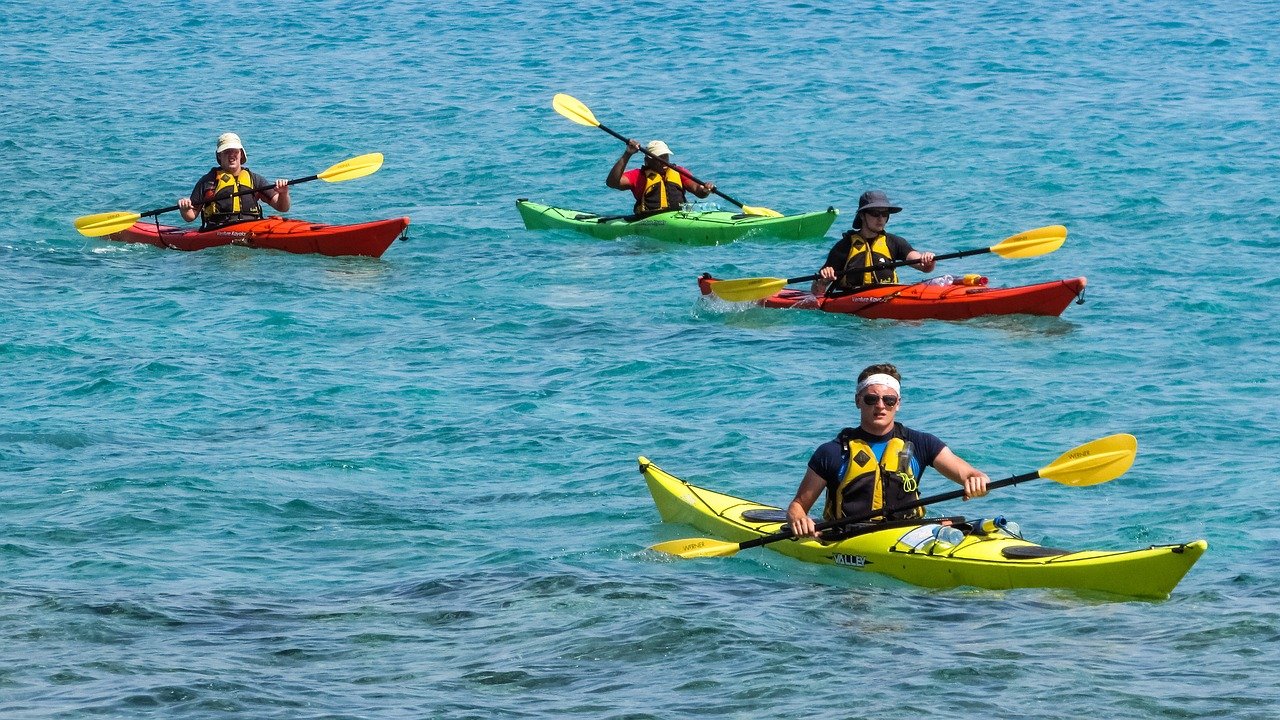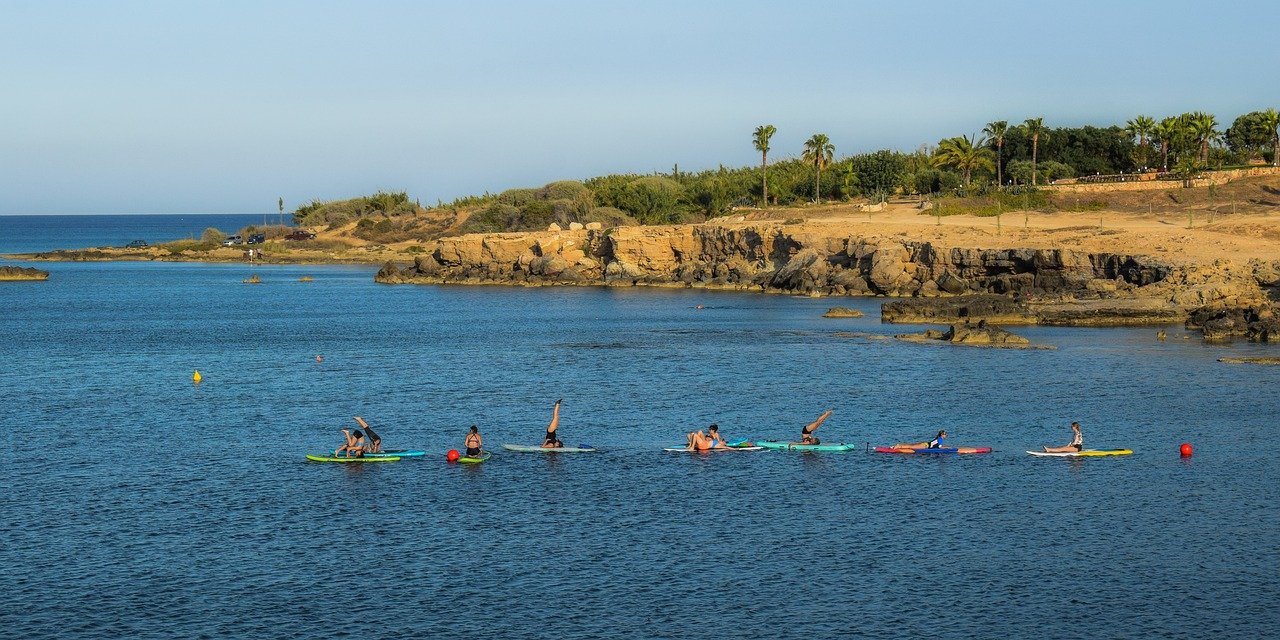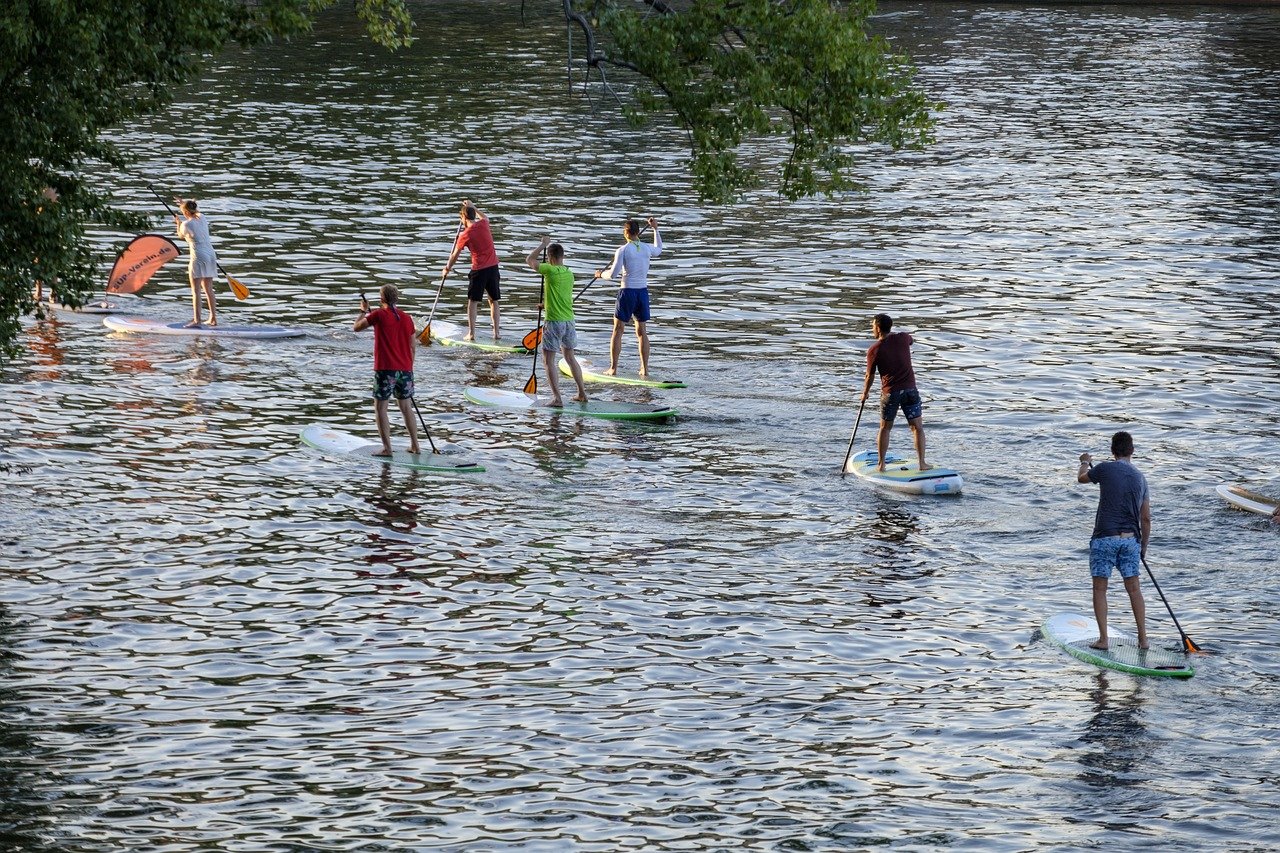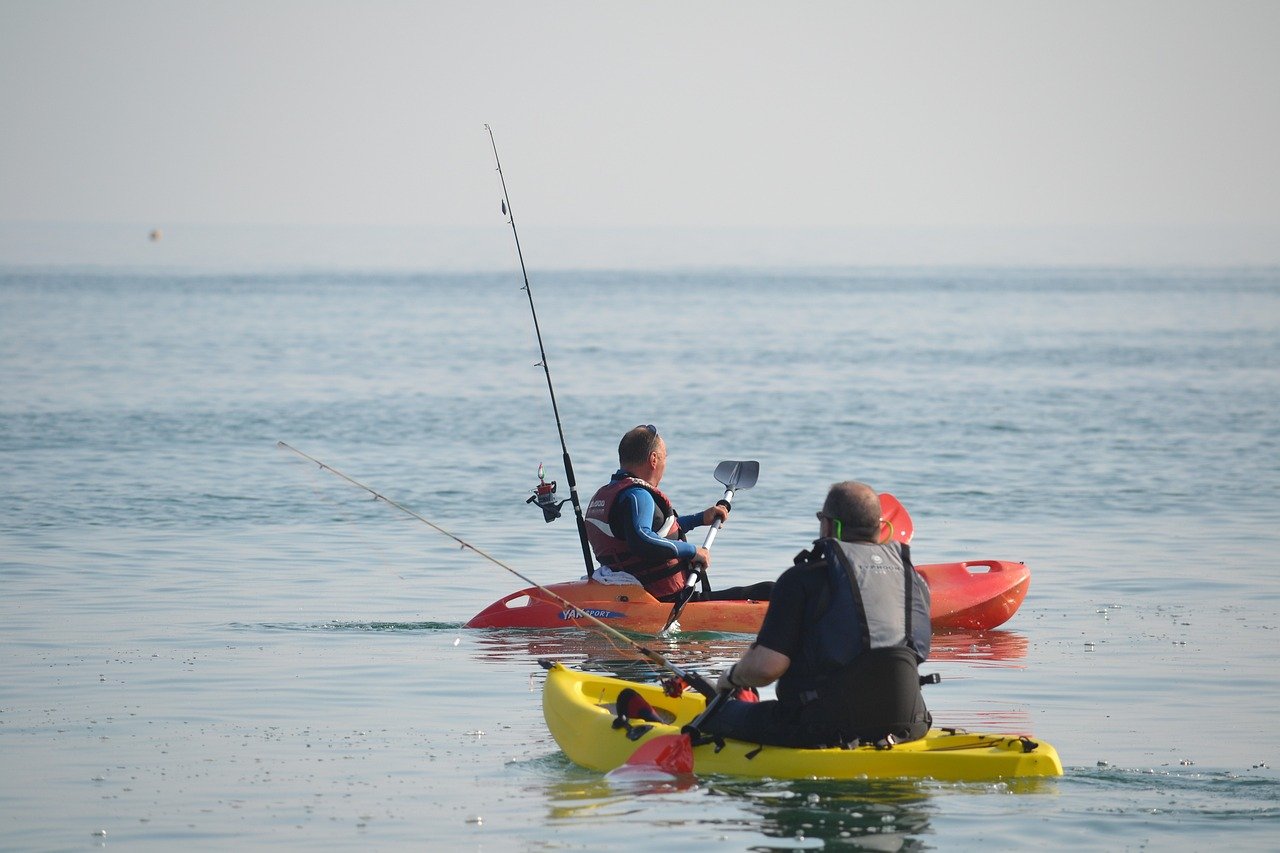Kayaking is a fantastic way to explore nature, get some exercise, and enjoy the serenity of the water. Whether you’re paddling down a lazy river, exploring coastal shores, or challenging yourself on a rushing whitewater course, kayaking offers a unique blend of adventure and tranquillity. However, like any outdoor activity, it’s important to be well-prepared and knowledgeable to ensure both safety and enjoyment. This comprehensive guide covers essential tips and advice for both beginners and experienced kayakers, helping you to make the most of your time on the water.
Packed with expert kayaking tips, this guide covers everything from selecting the right gear to mastering essential techniques, ensuring you’re fully prepared for a safe and enjoyable paddling adventure
1. Picking the Right Kayak
Before setting out on any kayaking adventure, selecting the appropriate kayak for your needs is crucial. There are several types of kayaks designed for different water conditions and activities.
- Recreational Kayaks: These are ideal for beginners and those looking for a relaxed experience on calm waters such as lakes or slow-moving rivers. They are usually wider, offering more stability, which makes them great for leisurely paddles.
- Touring Kayaks: Designed for longer trips on larger bodies of water, touring kayaks are longer and more streamlined. They have more storage space and are built to handle rougher water and wind conditions, making them perfect for multi-day trips.
- Whitewater Kayaks: These kayaks are shorter and more maneuverable, specifically designed for navigating fast-moving rivers and rapids. Whitewater kayaking requires specialized skills and a sturdy kayak that can withstand the challenging conditions.
- Inflatable Kayaks: Lightweight and portable, inflatable kayaks are a great option for those with limited storage space or who want something easy to transport. They can be used in a variety of water conditions, though they are generally less durable than hard-shell kayaks. There are the best inflatable kayaks review suggest for you.
When choosing a kayak, also consider the material. Plastic kayaks are durable and affordable, while composite kayaks made of fiberglass or carbon fiber are lighter and more expensive. Your choice will depend on your budget, how often you plan to kayak, and the types of water you will encounter.
2. Essential Gear and Equipment
Having the right gear can make a significant difference in your kayaking experience. Here’s a list of must-have equipment to ensure safety and comfort on the water.
- Personal Flotation Device (PFD): Always wear a life jacket, even if you’re an experienced swimmer. A PFD is the most important safety item and is required by law in many places.
- Paddle: Choose a paddle that suits your height and the type of kayaking you’ll be doing. A longer paddle is generally better for touring, while a shorter paddle may be more suitable for whitewater kayaking.
- Helmet: If you’re kayaking in whitewater or areas with potential for falling debris, a helmet is essential. It protects your head from impacts with rocks, the kayak, or other hazards.
- Spray Skirt: A spray skirt helps keep water out of your kayak, particularly in rough conditions or when rolling. It is essential for whitewater and sea kayaking to prevent swamping.
- Dry Bags: Protect your gear from getting wet by storing it in dry bags. These waterproof bags come in various sizes and can be used to keep clothing, electronics, and other valuables dry.
- Appropriate Clothing: Wear quick-drying, moisture-wicking clothing, and avoid cotton as it retains water and can lead to hypothermia. In cold conditions, consider a wetsuit or drysuit to stay warm.
- Footwear: Water shoes or sandals with good grip are ideal for kayaking. They protect your feet from sharp rocks and provide traction when entering or exiting the kayak.
- First-Aid Kit: A compact first-aid kit tailored for water sports is essential for treating minor injuries or dealing with emergencies on the water.
- Navigation Tools: If you’re exploring unfamiliar waters, bring a map, compass, or GPS device. Even if you have a general sense of direction, it’s easy to get disoriented on large lakes or coastal waters.
- Whistle or Signal Device: In case of emergency, a whistle can help alert others to your location. Some PFDs come equipped with a whistle, or you can attach one to your gear.
3. Understanding Water Conditions
Being aware of the water conditions is critical to planning a safe kayaking trip. Different environments present unique challenges, and understanding these can help you prepare and respond appropriately.
- Calm Waters: Lakes, ponds, and slow-moving rivers are ideal for beginners. The water is generally calm, making it easier to paddle and stay balanced. However, keep an eye on the weather, as sudden winds or storms can create choppy conditions.
- Rivers and Streams: Moving water requires more skill to navigate. Pay attention to the river’s flow rate, and be prepared for obstacles like rocks, branches, and rapids. It’s crucial to know how to read the river and anticipate changes in the current.
- Coastal Waters: Kayaking along the coast can be breathtaking, but it comes with the challenges of tides, waves, and wind. Understand the tide schedules and how they can affect your route. Be mindful of the weather forecast, as winds can quickly turn a pleasant paddle into a dangerous situation.
- Whitewater: This is the most challenging and dangerous type of kayaking, reserved for experienced paddlers. Whitewater rivers are classified into grades (I to VI) based on their difficulty. It’s essential to choose a river that matches your skill level and to be prepared with the right gear, including a helmet, throw rope, and a reliable spray skirt.
- Cold Water: If you’re kayaking in cold water, even in warm weather, be aware of the risk of hypothermia. Always wear appropriate gear, like a wetsuit or drysuit, and minimize exposure to the water. Cold water can quickly sap your strength and affect your ability to paddle.
4. Basic Kayaking Techniques
To enjoy kayaking safely, it’s important to learn and practice some basic techniques. Proper paddling techniques not only help you move efficiently but also reduce the risk of injury.
- The Forward Stroke: This is the most basic and commonly used stroke. It involves dipping the paddle blade into the water near your feet and pulling it back in a straight line alongside the kayak. Rotate your torso to engage your core muscles, which helps in preventing arm fatigue.
- The Reverse Stroke: Used to slow down or move backward, the reverse stroke is essentially the opposite of the forward stroke. Rotate your torso and push the paddle blade forward in a straight line alongside the kayak.
- The Sweep Stroke: This stroke is used to turn the kayak. Place the paddle blade in the water at the front of the kayak and sweep it in a wide arc towards the back. This will turn the kayak in the opposite direction of the stroke.
- The Draw Stroke: To move the kayak sideways, use the draw stroke. Extend the paddle out to the side of the kayak, dip the blade into the water, and pull it directly towards the kayak.
- Bracing: Bracing techniques help prevent capsizing. Low braces involve using the paddle to push against the water to regain balance, while high braces use the top edge of the paddle for a stronger push against the water. Practicing these can help you stay upright in choppy conditions.
- Edging and Leaning: By shifting your weight and edging the kayak (tilting it slightly), you can make sharper turns and better navigate rough water. Leaning requires practice, as too much can lead to capsizing, but it’s an essential skill for advanced kayaking.
5. Safety Precautions and Best Practices
Safety should always be your top priority when kayaking. Being prepared and cautious can prevent accidents and ensure that your trip is enjoyable.
- Check the Weather: Always check the weather forecast before heading out. Avoid kayaking in thunderstorms, strong winds, or heavy rain. Even if the weather looks fine, conditions can change quickly, especially on large bodies of water.
- Know Your Limits: Be honest about your skill level and physical fitness. Don’t attempt challenging routes or rough water if you’re not experienced. Start with easier trips and gradually build your skills.
- Never Kayak Alone: It’s always safer to kayak with a partner or in a group. In case of an emergency, having someone there to help can make all the difference. If you do kayak alone, make sure someone knows your plans and estimated return time.
- Practice Self-Rescue Techniques: Learn and practice self-rescue techniques like the wet exit (how to get out of the kayak if it capsizes) and re-entry methods. Knowing how to get back into your kayak or roll it upright is crucial, especially in deep or rough water.
- Stay Hydrated and Energized: Bring plenty of water and snacks to stay hydrated and maintain your energy levels. Paddling can be physically demanding, and dehydration or low energy can lead to mistakes or accidents.
- Respect Wildlife: If you’re kayaking in an area with wildlife, be respectful and maintain a safe distance. Avoid disturbing animals or damaging their habitats. This not only protects the wildlife but also ensures your safety.
- Understand and Follow Local Regulations: Different areas have specific rules and regulations for kayaking. These might include no-wake zones, restricted areas, or required safety equipment. Familiarize yourself with the local laws and follow them to avoid fines and ensure a safe trip.
- Be Mindful of Other Water Users: Rivers, lakes, and coastal waters are often shared with other boaters, fishermen, and swimmers. Be courteous and give others plenty of space. Understanding right-of-way rules and signaling your intentions can help avoid collisions.
6. Environmental Stewardship
Kayaking offers a unique way to connect with nature, but it’s important to act as a responsible steward of the environment. Protecting the waterways and surrounding ecosystems ensures that these beautiful places remain pristine for future generations. Here are some ways you can minimize your environmental impact while kayaking:
- Leave No Trace: The Leave No Trace principles are a set of guidelines designed to minimize human impact on natural environments. When kayaking, this means taking all your trash with you, avoiding the use of single-use plastics, and not disturbing wildlife. Leave the area as you found it—or better.
- Be Cautious of Invasive Species: Invasive species can hitch a ride on your kayak, paddles, or gear, and be transported to new environments, where they can cause ecological damage. Before moving your kayak between different bodies of water, clean, drain, and dry all your equipment thoroughly to prevent the spread of invasive species.
- Avoid Sensitive Areas: Some ecosystems are particularly fragile, such as wetlands, coral reefs, and mangrove forests. Paddling through these areas can cause significant harm. Stick to established routes and avoid shallow areas where your kayak could damage underwater habitats.
- Use Biodegradable Products: If you need to use soap, sunscreen, or other personal care products while kayaking, opt for biodegradable options. Regular products can introduce harmful chemicals into the water, disrupting the local ecosystem.
- Participate in Clean-Up Efforts: Join or organize local waterway clean-up efforts. Collecting trash while you’re out on the water not only improves the environment but also sets a positive example for others.
- Support Conservation Efforts: Contribute to organizations that work to protect and restore waterways. Whether through donations, volunteering, or advocacy, your support can help ensure that these natural spaces are preserved.
7. Planning Your Kayaking Trip
Proper planning is the key to a successful kayaking adventure. Whether you’re going for a short paddle or an extended expedition, taking the time to prepare can make all the difference.
- Choose Your Destination Wisely: Select a location that matches your skill level and interests. Research the area to understand the water conditions, weather patterns, and any potential hazards. Consider whether you want a solo experience or prefer a popular spot with other kayakers.
- Map Out Your Route: Plan your route in advance, considering the distance, water conditions, and potential stopping points. If you’re unfamiliar with the area, talk to local experts or consult guidebooks for advice on the best routes.
- Check Permits and Regulations: Some areas require permits for kayaking, especially in national parks or protected areas. Make sure you have all necessary permits and understand the regulations before you go.
- Prepare for the Unexpected: Always have a backup plan in case things don’t go as expected. This could include alternate routes, emergency contacts, and knowledge of the nearest medical facilities. If you’re on a multi-day trip, have a plan for shelter, food, and water resupply.
- Pack Accordingly: Bring enough supplies for the duration of your trip, including food, water, and extra clothing. For longer trips, pack camping gear, a portable stove, and enough provisions to last the entire journey. Don’t forget a repair kit for your kayak and paddles.
- Inform Someone of Your Plans: Always let someone know your itinerary and expected return time, especially if you’re paddling alone. In the event of an emergency, this information could be vital for search and rescue teams.
- Consider Joining a Guided Tour: If you’re new to kayaking or exploring a challenging area, consider joining a guided tour. Experienced guides can provide valuable local knowledge, ensure your safety, and enhance your experience.
8. Improving Your Kayaking Skills
Kayaking is a skill that improves with practice and experience. Whether you’re a beginner or have been paddling for years, there’s always room for improvement. Here are some ways to hone your skills:
- Take a Kayaking Course: Enrolling in a kayaking course is a great way to learn or improve your skills. Many outdoor recreation centers offer classes on everything from basic paddling techniques to advanced whitewater maneuvers. A certified instructor can provide personalized feedback and help you progress faster.
- Practice in Different Conditions: To become a versatile kayaker, practice in a variety of water conditions. This includes calm lakes, flowing rivers, and coastal waters. Each environment presents different challenges, and by gaining experience in each, you’ll become more confident and capable.
- Work on Your Endurance: Kayaking can be physically demanding, especially on longer trips or in rough water. Building your stamina through regular exercise and strength training can make paddling more enjoyable and reduce the risk of injury. Focus on exercises that target your core, shoulders, and arms.
- Join a Kayaking Club: Joining a local kayaking club is a fantastic way to meet other paddlers, share knowledge, and participate in group outings. Club members often organize trips, provide mentorship, and create a sense of community among kayakers.
- Learn Advanced Techniques: Once you’re comfortable with the basics, challenge yourself by learning advanced techniques such as the Eskimo roll, which allows you to right a capsized kayak without exiting. Advanced rescue techniques, paddling in surf, and navigating strong currents are also valuable skills for more experienced kayakers.
- Record and Review Your Progress: If possible, record videos of yourself kayaking. Watching these videos can help you identify areas where you can improve your technique, posture, and efficiency. Over time, this self-analysis can lead to significant improvements in your skills.
9. Connecting with the Kayaking Community
Kayaking is more than just a solo activity; it’s also a great way to connect with others who share your passion for the water. Engaging with the kayaking community can enrich your experience and open up new opportunities.
- Attend Kayaking Events and Festivals: Many regions host kayaking events, from local races to international festivals. Attending these events is a great way to meet other kayakers, learn from experts, and participate in a variety of paddling activities.
- Follow Kayaking Forums and Social Media Groups: Online forums and social media groups are valuable resources for connecting with other kayakers. These platforms allow you to ask questions, share experiences, and stay updated on the latest kayaking news and gear. Join Kayaks Group : meetup, facebook,
- Volunteer for Kayaking Organizations: Many organizations work to protect waterways and promote kayaking. Volunteering with these groups can deepen your connection to the sport and give you a chance to contribute to the kayaking community.
- Share Your Experiences: Consider starting a blog, YouTube channel, or social media page to share your kayaking adventures. Not only does this allow you to document your experiences, but it also helps inspire others to take up the sport.
10. Kayaking with a Purpose
While kayaking is often seen as a recreational activity, it can also be a powerful tool for making a difference. Many kayakers use their paddling skills to support causes they care about.
- Environmental Monitoring: Kayakers can help monitor the health of waterways by collecting water samples, documenting pollution, or recording wildlife sightings. This data can be valuable for scientists and conservationists working to protect aquatic ecosystems.
- Fundraising and Awareness Campaigns: Some kayakers undertake long-distance paddling journeys to raise money or awareness for causes such as environmental conservation, mental health, or social justice. These journeys can attract media attention and inspire others to contribute.
- Disaster Relief: In the aftermath of natural disasters, kayaks can be used to access areas that are difficult to reach by other means. Some kayakers volunteer their time and skills to assist in relief efforts, delivering supplies or helping with evacuations.
- Educational Outreach: Kayakers with a passion for teaching can offer free or low-cost lessons to underserved communities, introducing others to the joys of paddling. Educational outreach can also include organizing clean-up events or environmental workshops.
11. Kayaking for Mental and Physical Health
Beyond the obvious physical benefits, kayaking also offers numerous mental health advantages. Engaging in regular kayaking can improve your overall well-being in several ways:
- Stress Relief: The calming effect of being on the water, combined with the rhythmic motion of paddling, can significantly reduce stress levels. Many kayakers find that time on the water helps them disconnect from daily pressures and clear their minds.
- Mindfulness and Meditation: Kayaking provides an excellent opportunity to practice mindfulness, focusing on the present moment. The natural surroundings and the soothing sounds of water can make kayaking a meditative experience, promoting mental clarity and peace.
- Improved Cardiovascular Health: Paddling is a great cardiovascular workout, improving heart health, increasing endurance, and helping to maintain a healthy weight. Regular kayaking can lead to improved physical fitness and lower the risk of heart disease.
- Enhanced Focus and Concentration: Navigating waterways, reading water conditions, and responding to changes in the environment require concentration and quick decision-making. These skills can translate to improved focus in other areas of life.
- Social Connection: Kayaking with others fosters social connections, which are crucial for mental health. Whether you’re joining a group outing or simply sharing your passion with a friend, kayaking can strengthen relationships and combat feelings of isolation.
12. Final Thoughts: Enjoying Kayaking Responsibly
Kayaking is a rewarding and enriching activity that offers countless opportunities for adventure, relaxation, and personal growth. By following the tips and guidelines outlined in this article, you can ensure that your kayaking tips experience is both safe and enjoyable.
Remember to respect the environment, continue learning and improving your skills, and connect with the broader kayaking community. Whether you’re paddling on a quiet lake, navigating a fast-moving river, or exploring the open sea, kayaking allows you.



